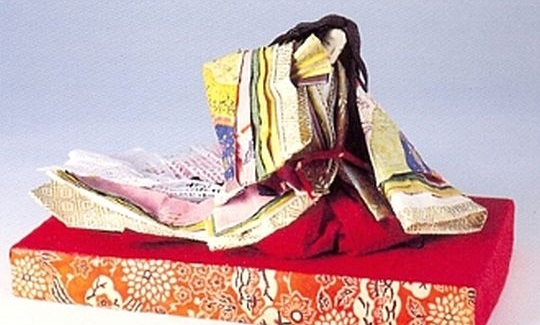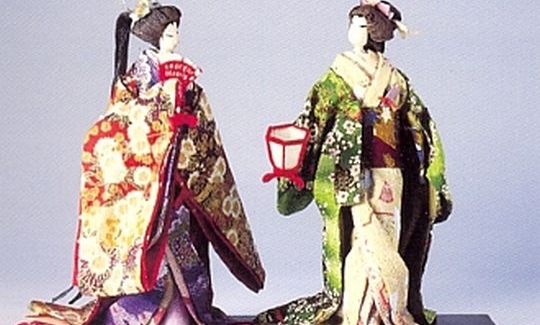Japanese Paper Dolls
With the onset of spring, on March 3rd, the Hina-matsuri, the Doll Festival, takes place in Japan, in which dolls have a specific role to play.
The festival originated in the 12th century, when the peasants celebrated the coming of spring and prepared to plant their rice. They made coarse, clumsy dolls of paper or straw and floated them on the river, in the belief that they would carry away bad luck and illness with them as they sank beneath the water. So that the paper doll has never been a child's plaything, but rather a charm to protect its maker.
At the same time, the aristocracy began to decorate their homes with fifteen dolls, each personifying a member of the emperor's court, in order to safeguard the monarch. They included the emperor and the empress, three female attendants, five musicians, two ministers, and three guards.
As the years passed, these dolls became more and more magnificent, and the custom spread to all ranks of society. On the evening of March 3rd, mothers and daughters were busy preparing a little red platform for the royal couple, presenting tributes to the gods, and offering sweets to the children of neighbours who had been invited to their homes.
The custom reached its height during the reign of the Shogun lenari (1773-1841), who had many daughters, lenari wanted Japan to he protected from all outside influence by safeguarding the customs of the feudal world and the court, all the characteristics of the Japanese way of life.
By playing with dolls, little girls learned the traditional practices for older girls and for women - flower arrangement, the tea ceremony, and paper-folding (origami).
The dolls in the workers' houses of Edo (which is now Tokyo) were not expensive, as were those to be found in the Imperial Palace at Kyoto. Like the dolls floated on the rivers by the peasants as charms, they were made of paper. These paper dolls were elegant and lovely. Hair was made from crinkled paper, and the hairstyles were appropriate to each age. The layers of the kimono garments were made of coloured or printed paper according to the aesthetic rules of traditional dress. The dolls were made more realistic by embellishments of cut paper stencils or by painting in the eyes and mouths The Japanese cared for their dolls as treasures, and made sure that they did not fall into the destructive hands of small children. At the end of the Edo period (1603- 1868), and in particular at the beginning of the Meiji era (1868-1912). the art of making paper dolls became a leisure-time occupation for adults.
In Japanese, the paper dolls are known as 'Ane-sama-ningyo' (Ane-sama - eldest sister; ningyo - doll). When the eldest son married, his little sisters addressed his wife as "big sister". The dream of these small girls was to become a bride and wear the beautiful bridal gown, so they made paper dolls in bride's dress ־ - which is why the paper dolls are so named.
As with other popular crafts in Japan, the paper dolls can be categorized according to the area in which they are created, by their type, colouring, and style. Faces of the traditional dolls have no features, perhaps so that everyone can see their own reflected in the doll. Some dolls turn their backs on the viewer, the better to display their traditional hairstyles. The heads are made of cotton covered with white paper, and the hairstyle offers important clues to the age and rank of the figure represented.
Paper dolls by the artist Kimiyo Furukawa, and covering a wide spectrum of subjects are to be seen in this exhibition. They represent characters from legend, literature, history, and the daily life of the various periods. The dolls' clothing is magnificent, a lively witness to the fashionable dress of bygone days. The dolls representing male actors from the repertoire of the Kabuki Theatre create a theatrical impression by means of their varying expressions, their make-up and attitudes, and their stylized costumes. All this combines to make the paper dolls an art form which is often compared to the art of porcelain.
Kimiyo Furukawa - Artist of the Paper Doll
Kimiyo Furukawa was born in Tokyo in 1914. After finishing high school in Toyoeiwa in 1933 she began to learn the art of making fabric dolls, and hoped to become a doll-maker. However when, in 1937, she married Seiichi Furukawa, she had to abandon her dream. She went to China with her husband, who became a Japanese government official in Manchuria. In 1946, after he was killed in the Second World War, Mrs. Furukawa returned to Japan with her mother and her two children.
In Japan she worked as a dressmaker to support her family and bring up her children. For all that, she retained her love of the paper dolls. In 1962, at the age of 48, she studied paper-doll construction at a school in Tokyo. Mrs. Furukawa's dolls were so beautiful that her neighbours begged her to teach them too. In order to prepare the dolls for her neighbours, she began to perfect her craft. In the sixties her dolls had no features, and their clothing was very simple. Gradually. Mrs. Furukawa began to design dolls derived from the ukiyo-e, the traditional Japanese prints. She is particularly interested in the genre 'beautiful women' (bijin-ga). Mrs. Furukawa is an expert on the hairstyles and clothing which were fashionable in Japan during the Edo period (1603-1868). In those days clothing and hair were arranged In accordance with the social status and occupation of the women. After repeated attempts. Mrs. Furukawa was finally able to create the appropriate coiffures and details of dress, even though she was told that they were no longer in fashion. Today she knows how to create some fifty coiffures and costumes, all from paper. She has made, to date, some three hundred paper dolls, of which one hundred are displayed in this exhibition.




